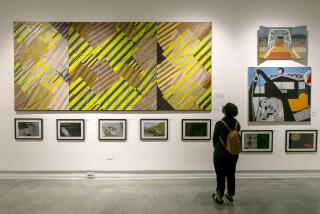A Los Angeles Treasure That Got Away : Art: The late Harry Franklin’s collection of Melanesian works has been donated to Dartmouth College.
- Share via
Los Angeles lost its premier collection of African art last year in a record-breaking New York auction. Now the city’s foremost holding of Oceanic art has quietly slipped away in a donation to the Hood Museum of Art at Dartmouth College in Hanover, N.H. Both groups of artworks were amassed by Harry A. Franklin, a pioneering dealer and collector who owned a gallery in Beverly Hills and died in 1983.
Los Angeles’ latest loss of ethnographic art is the Harry A. Franklin Family Collection of Oceanic Art, which includes about 1,000 objects and is said to be the most comprehensive private collection of Melanesian art in the United States. The value of the gift has not been disclosed.
The donation consists of artworks from Papua New Guinea and Vanuatu which exemplify the rich artistic traditions of Pacific island cultures. The objects--including painted bark panels, ancestral boards, masks, sculptural figures and drums--are generally characterized by profusely detailed carving or painting. The works range in size from tiny carvings to an 8 1/2-foot figure carved from a tree-fern trunk and a 14-foot slit-drum.
Franklin’s daughter, Valerie, an art historian who joined the family business in 1970 and ran the gallery for five years after her father’s death, said she had hoped to find Southern California homes for both collections but her efforts were unsuccessful. She sold the African art collection--the most valuable part of the family holdings--to launch a new career as a writer. The historic sale of 431 objects brought more than $7 million at Sotheby’s New York, a record for any auction of African art. A Cameroon sculpture called the “Bangwa Queen” sold for $3.4 million, more than double the record for an African artwork.
Franklin said she decided to give the Oceanic collection to the Hood Museum of Art because she was persuaded that the artworks would be well cared for and integrated into Dartmouth’s educational program. “I wanted to be sure that the collection was used. I didn’t want it to end up as dead weight in some storehouse. Also, I was impressed with the way the different departments--anthropology, art history and applied arts--work together at Dartmouth,” she said. Noting that the collection offers a wide array of interdisciplinary opportunities for display and study, Franklin said the gift will be “of great use to scholars and the public for generations to come. I think that’s a fitting tribute to my father.”
Harry A. Franklin, who began collecting art in 1938, opened his first gallery in 1955. Although he initially collected paintings, he soon moved into so-called primitive art and was widely revered as one of the earliest collectors to appreciate its aesthetic worth.
Valerie Franklin was introduced to Dartmouth by Tamara Northern, senior curator at the Hood. A leading authority on Cameroon art, Northern wrote the catalogue for the Smithsonian Institution’s 1984-85 traveling exhibition of Cameroon art, which prominently featured Franklin-owned works. She also authored the catalogue for a show of the Franklin collection that toured the United States from 1986 to 1989.
“There’s great excitement here (about the Franklin gift),” Northern said. But accepting such a large donation is a major undertaking that constitutes a real commitment, she said, noting that the college is making plans to bring in experts in Oceanic art and to incorporate the material into its program.
The Hood Museum of Art is housed in a 1985 post-modern building designed by Charles Moore. The Franklin collection will join a general art collection of 45,000 objects, about half of which are ethnographic, Northern said. Among other holdings are northern native American, African and pre-Columbian works.
More to Read
The biggest entertainment stories
Get our big stories about Hollywood, film, television, music, arts, culture and more right in your inbox as soon as they publish.
You may occasionally receive promotional content from the Los Angeles Times.










